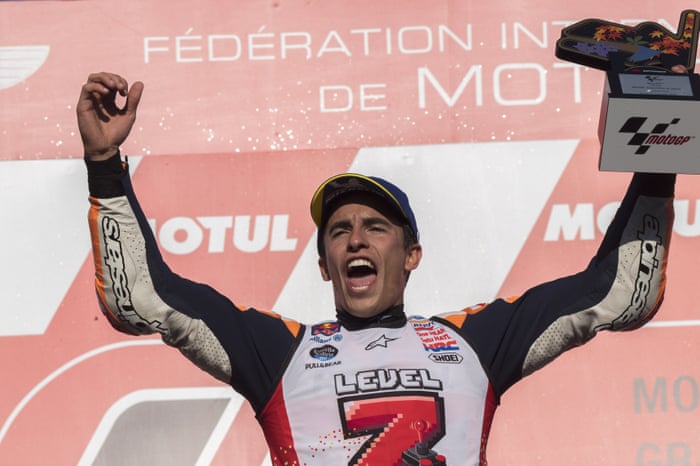
On Sunday at the Motegi circuit in Japan, Marc Márquez pulled off what Lewis Hamilton couldn't exactly figure out how to accomplish 15 hours after the fact and 6,500 miles away in Texas: he won his fifth big showdown in the best level of his game with three races to go. Presently he stands level with Mick Doohan, the Australian ace of the 1990s, and just two titles from Valentino Rossi's seven and three from Giacomo Agostini, who won his eight titles somewhere in the range of 1966 and 1975.
The Catalan's five MotoGP titles have come in the six seasons since he moved on from Moto2. As he is just 25, and there is no sign that achievement is bringing some relief his craving, there is each probability he will match and after that outperform Agostini's aggregate. This would be a reasonable impression of an ability that could be compared to those shown by Lionel Messi in football, Brian Lara in cricket, Simone Biles in acrobatic and Roger Federer in tennis: the capacity to take a given arrangement of parameters and twist them into new shapes, making an exhibition that leaves everybody, including their adversaries, shaking their heads in wonderment.
Márquez was given his first motorbike at four years old, as a Christmas present. Twenty after one years he rides his Honda RC213V as though he were conceived on it, imparting a virtuous feeling of pleasure notwithstanding when the fight is at its generally serious. To watch him cornering his machine at fast with its two wheels pointing in various ways, the count of brake, throttle and lean edge shaping an always showing signs of change condition to set against a vibe for the hold of elastic on black-top, is to observe the most elevated amount of virtuosity. Now and then the machine appears to be more similar to a move accomplice than a bike – and a move on ice, at that.
Tangle Oxley, the most insightful of the present age of authors on bike dashing, compares him to Jimi Hendrix – the Hendrix who played guitar with his teeth, going past acknowledged specialized points of confinement. Yet, Hendrix, knowing he didn't play the guitar so well with his teeth similarly as with his fingers, played out that trap for show. At the point when Márquez investigates another system, it's for go. It's to get him through a corner quicker that the person whose fumes exhaust he has been relaxing.
He doesn't so much disrupt the norms as rethink them, constraining everybody who needs to contend with him – and every single youthful rider joining the game afterward – to adjust their styles with the end goal to stand a shot of keeping up. Others have had a comparable effect previously, prominently Rossi, yet Márquez has gone substantially further and made the game an additionally exciting display accordingly.
This doesn't involve being on the best machine, as is in some cases the case with Formula One's heroes. MotoGP's guidelines by and large prevail with regards to making a moderately even focused harmony between the best works groups – Honda, Ducati, Yamaha, Suzuki – while leaving enough space for every maker to make a bicycle that has its own individual attributes as far as power or taking care of. So on Sunday morning we watched Márquez misusing his Honda's deftness to stalk Andrea Dovizioso's smooth-riding Ducati, pressing past the Italian to lead the pack in the later stages and inciting him into the edgy counterattack.
He and Dovizioso have battled without holding back all through the season, with a few last-corner dramatizations. Before that his main adversary was Jorge Lorenzo, the Spaniard who prevailing with regards to intruding on Márquez's kept running of titles in 2015 on a Yamaha. Next season Lorenzo will leave Ducati – for whom he has won three races this season, to Márquez's eight and Dovizioso's three – to join Márquez at Repsol Honda. "I requested a solid partner," Márquez said when the move was declared, "however not so solid."
With any good fortune, this will resemble Mansell and Piquet at Williams or Senna and Prost at McLaren: two in number willed contenders of coordinating ability and differentiating character who are not hesitant to conflict off the bicycle and in addition on it. They have tangled on numerous events, remarkably this season at Misano, where Lorenzo conceded culpability, and at Aragon, where he stated: "Marc crushed my race, obliterated my foot, wrecked the enormous plausibility I needed to win." The damage constrained him to miss the following two races.
For all his celestial grin, Márquez is a hard and merciless contender who was allowed a 30-second punishment and a stern cautioning in the wake of riding Rossi off the track amid a wild race in changing conditions in Argentina in April. He could be viewed as wedding a portion of the characteristics of Gilles Villeneuve, who put stock in driving the wheels off his auto in all conditions, with those of Max Verstappen, a wonder who sees no motivation behind why anyone, ever, ought to be before him (and whose drive from eighteenth on Sunday's matrix in Austin to second on the platform was somewhat neglected in the festival of Kimi Räikkönen's win).
MotoGP is fortunate to have Márquez, and Márquez is fortunate to have arrived in MotoGP when such extraordinary competitions are made conceivable by the development of an age of amazingly capable riders with solid and dissimilar identities – somewhat like the enormous four in men's tennis over the previous decade. He is the sort of figure all games long for uncovering: a Tiger Woods, a Katarina Witt, a Usain Bolt, a novel person whose blend of mystique and specialized splendor blasts through the points of confinement and orders of their game and connects with hoards.
No comments:
Post a Comment